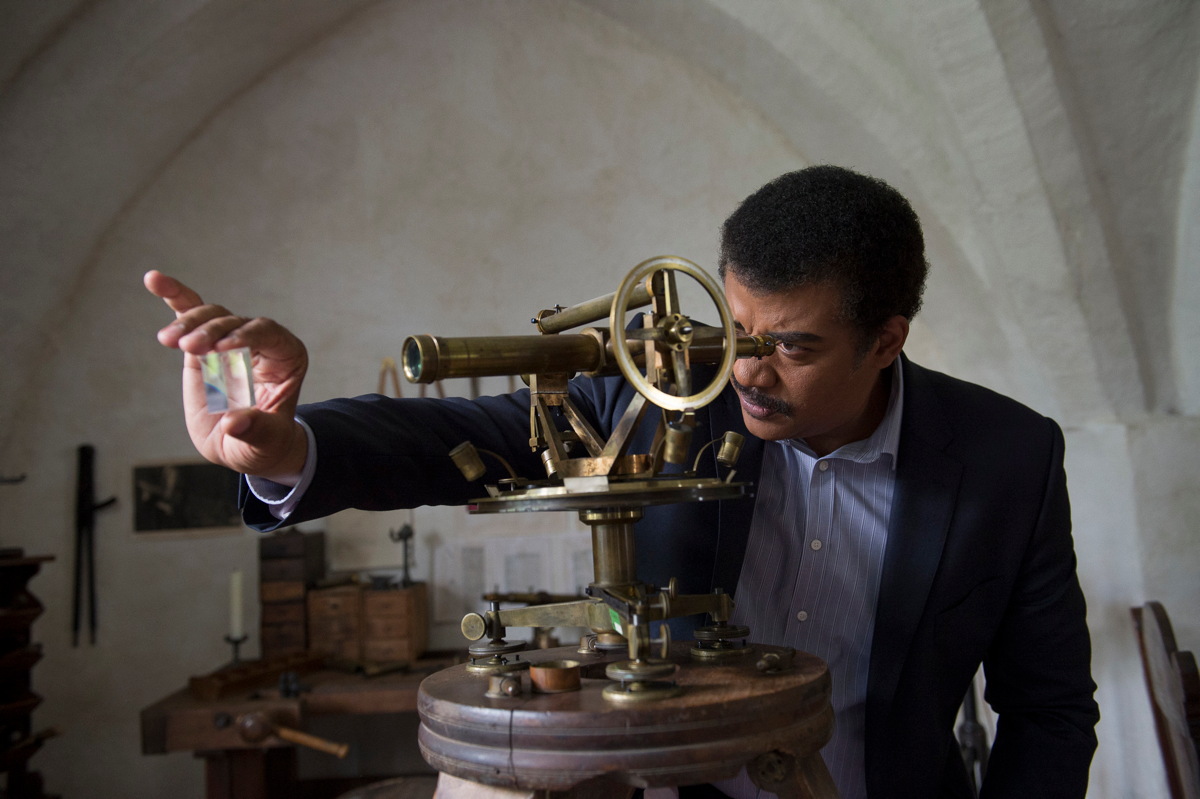'Cosmos' Recap: 'Magic Tricks' of Light Illuminated

Secrets of the universe are hiding inside light.
Sunday's (April 6) episode of "Cosmos: A Spacetime Odyssey" explored some of those secrets in stunning detail and animation. From the quantum level to light emitted by distant stars and galaxies, "Cosmos" host and astrophysicist Neil deGrasse Tyson took viewers on a tour of how light works on the smallest and largest levels.
The episode, titled "Hiding in the Light," starts with an imagined story from prehistory and extends outward to the development of modern astrophysics. Tyson explains that light falling onto the walls of the first cave-dwelling humans' homes might have inspired them to pick up pigment and create the first art. [Watch a "Cosmos" Preview for "Hiding in the Light"]
"Somewhere, long ago, someone glanced up to see light perform one of its magic tricks," Tyson said during the new "Cosmos," a reboot of Carl Sagan's original series. "Who knows? Maybe that quirk of light inspired the very first artists," Tyson said.
The episode paid tribute to William Herschel, who discovered infrared wavelengths of light. Herschel saw that there are wavelengths that cannot be seen by the human eye, below red on the rainbow spectrum of light. His discovery directly paved the way for infrared telescopes like NASA's Spitzer Space Telescope that can peer through the dust of the universe to see light from far-off stars hidden beneath it.
Herschel's discovery and other scientists' work with light actually led to the development of Tyson's own field of astrophysics. Joseph von Fraunhofer, another scientist, saw dark lines in the rainbow of the visible spectrum when he was examining it.
"When you look at a star with a spectroscope, you see the dark lines from all the elements in its atmosphere," Tyson said. "Show me the spectrum of anything, whether here on Earth or a distant star; I'll tell you what it's made of. [von] Fraunhofer's lines are the atomic signatures of the elements writ-large across the cosmos."
Get the Space.com Newsletter
Breaking space news, the latest updates on rocket launches, skywatching events and more!
"Hiding in the Light" also focused on the lives of early scientists who helped define science itself with their work on primitive cameras, telescopes and the scientific method. Mo Tzu, a philosopher who lived in China more than 2,000 years ago, created the first camera, Tyson said during the show.
Tyson discussed Ibn al-Haytham, played by the actor Alfred Molina ("Raiders of the Lost Ark"), a physicist credited with learning how the eye works. He is also credited with developing the scientific method.
"This is the method of science, so powerful that it has carried our robotic emissaries to the edge of the solar system and beyond," Tyson said. "It has doubled our life span, made the lost worlds of the past come alive. Science has enabled us to predict events in the distant future, and to communicate with each other at the speed of light as I am with you right at this moment."
"Cosmos: A Spacetime Odyssey" airs Sunday at 9 p.m. ET/PT on Fox. It will be rebroadcast with extra material on the National Geographic Channel on Monday (April 7) at 10 p.m. ET/PT. Check local listings. To catch up on "Cosmos," you can watch the five previously aired episodes for free via Hulu.
Follow Miriam Kramer @mirikramer and Google+. Follow us @Spacedotcom, Facebook and Google+. Original article on Space.com.
Join our Space Forums to keep talking space on the latest missions, night sky and more! And if you have a news tip, correction or comment, let us know at: community@space.com.

Miriam Kramer joined Space.com as a Staff Writer in December 2012. Since then, she has floated in weightlessness on a zero-gravity flight, felt the pull of 4-Gs in a trainer aircraft and watched rockets soar into space from Florida and Virginia. She also served as Space.com's lead space entertainment reporter, and enjoys all aspects of space news, astronomy and commercial spaceflight. Miriam has also presented space stories during live interviews with Fox News and other TV and radio outlets. She originally hails from Knoxville, Tennessee where she and her family would take trips to dark spots on the outskirts of town to watch meteor showers every year. She loves to travel and one day hopes to see the northern lights in person. Miriam is currently a space reporter with Axios, writing the Axios Space newsletter. You can follow Miriam on Twitter.









